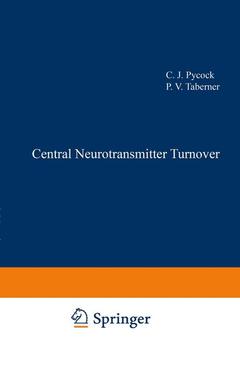Description
Central Neurotransmitter Turnover, 1981
Authors: Pycock C. J., Taberner P. V.
Language: English
Keywords
Approximative price 52.74 €
In Print (Delivery period: 15 days).
Add to cart
Publication date: 01-2012
197 p. · 14x21.6 cm · Paperback
197 p. · 14x21.6 cm · Paperback
Description
/li>Contents
/li>
The concept of chemical transmission in the central nervous system has taken some time to be generally accepted, but an increasing number of compounds are now being recognized as hav ing a transmitter role in the brain. The acetylcholine system was the first to be discovered in the periphery and its charac teristic features of storage of transmitter in vesicles in the nerve terminal, its electrically-evoked release and rapid extra neuronal breakdown were considered to be necessary criteria for any neurotransmitter candidate. The subsequent elucidation of the noradrenergic system made it apparent that rapid enzymatic breakdown was not essential for a released transmitter, and the possibility of high-affinity re-uptake processes became establ ished as an alternative means of terminating the synaptic actions of a transmitter. With the eventual acceptance of the amino acids as excitat ory or inhibitory transmitters, the requirement for a transmit ter to be present in a low concentration overall (although locally concentrated in specific terminals) also had to be discarded. This necessitated the additional concept of specif ic metabolic pools with different functions being located in different cells or within different regions of the same cell. Some localization of glutamate and aspartate remote from excit able membranes is clearly essential since their overall brain concentrations would be sufficient to maximally depolarize the majority of neurones in the brain. The concept of separate metabolic pools has been supported by stUdies on turnover rate (see Chapter 5).
List of Contents.- Section I Turnover of Central Neurotransmitters.- 1 The Turnover of Neurotransmitters in the Brain: An Introduction.- 2 The Turnover of Catecholamines.- 3 The Turnover of 5-Hydroxytryptamine.- 4 The Turnover of Acetylcholine.- 5 The Turnover of Transmitter Amino Acids,With Special Reference to GABA.- 6 The Turnover of Peptides.- Section II Application of Turnover Studies to Specific Problems.- Differences in Dopamine Metabolism in Rat Striatum andOlfactory Tubercle.- Changes in Central 5-Hydroxytryptamine Turnover inducedby Acute and Chronic Inhibition of the Re-uptake Process.- Tail Pinch Induced Gnawing: Voltammetric and BehaviouralEffects of Fenfluramine.- Analysis of CSF Amine Metabolites and Precursorsincluding Tryptophan, 5HIAA and HVA by HPLC using Fluorescence and Electrochemical Detection in Primates: Effects of Probenecid.- Species Differences in the Acetylation of [3H]Cholinein Cortical Slices.- The Effects of GABA Uptake Inhibitors including 2,4-Diaminobutyric Acid on GABA Metabolism in vivo.- Concomitant Determination of Endogenous Release of Dopamine, Noradrenaline, 5-Hydroxytryptamine and Thyrotrophin Releasing Hormone (TRH) from Rat Brain Slices and Synaptosomes.
© 2024 LAVOISIER S.A.S.




